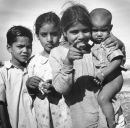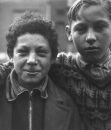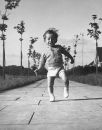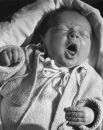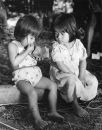Little Allies
Perhaps Suschitzky likes photographing children because of the close relationship he enjoyed with his elder sister Edith and because of the strong bonds that tie him to his “offspring,” as he affectionately calls his children, grandchildren and great grandchildren, all of whom take a keen interest in his life and vice versa. In 1946, his son Peter became the protagonist of a book of his own, That Baby – The story of Peter and his new brother, in addition he regularly photographed for children’s books, including The Flying Poodle and Brendan of Ireland.“
Perhaps it is no accident, that I have done much photography of children and animals. One cannot arrange either of them to any large extent. One has to wait with patience for the right moment. Children and animals have the further advantage, that they do not complain about the results.” The same attention is lavished on the children playing in London’s East End, so to speak on his door step, as on those he meets while filming all over the world. In India he encounters a group of little allies; while shooting Geoffrey Jones’ short film Trinidad and Tobago, he makes the acquaintance of two very unlike siblings; in Thailand, while filming an NBC documentary on Southeast Asia, he comes across two girls so engrossed in eating their noodles that they fail to even notice the photographer. Suschitzky bumps into the two boys in Burma, where he worked on a film called People Like Maria, directed by Harry Watt. The film showed the work of WHO in South America, Nigeria and Burma. “I met these two boys in a small village. The little one may have been afraid of me. Perhaps he had never seen a European before.”
One of Suschitzky’s first photographs was taken in Amsterdam’s Jewish quarter in 1934. “I was fascinated by the lively atmosphere of the place. Markets selling everything under the sun, amusing barkers attracting crowds, lots of children everywhere. There were 70,000 Jews in Amsterdam before the War, but only 10,000 survived.”
Perhaps it is no accident, that I have done much photography of children and animals. One cannot arrange either of them to any large extent. One has to wait with patience for the right moment. Children and animals have the further advantage, that they do not complain about the results.” The same attention is lavished on the children playing in London’s East End, so to speak on his door step, as on those he meets while filming all over the world. In India he encounters a group of little allies; while shooting Geoffrey Jones’ short film Trinidad and Tobago, he makes the acquaintance of two very unlike siblings; in Thailand, while filming an NBC documentary on Southeast Asia, he comes across two girls so engrossed in eating their noodles that they fail to even notice the photographer. Suschitzky bumps into the two boys in Burma, where he worked on a film called People Like Maria, directed by Harry Watt. The film showed the work of WHO in South America, Nigeria and Burma. “I met these two boys in a small village. The little one may have been afraid of me. Perhaps he had never seen a European before.”
One of Suschitzky’s first photographs was taken in Amsterdam’s Jewish quarter in 1934. “I was fascinated by the lively atmosphere of the place. Markets selling everything under the sun, amusing barkers attracting crowds, lots of children everywhere. There were 70,000 Jews in Amsterdam before the War, but only 10,000 survived.”




